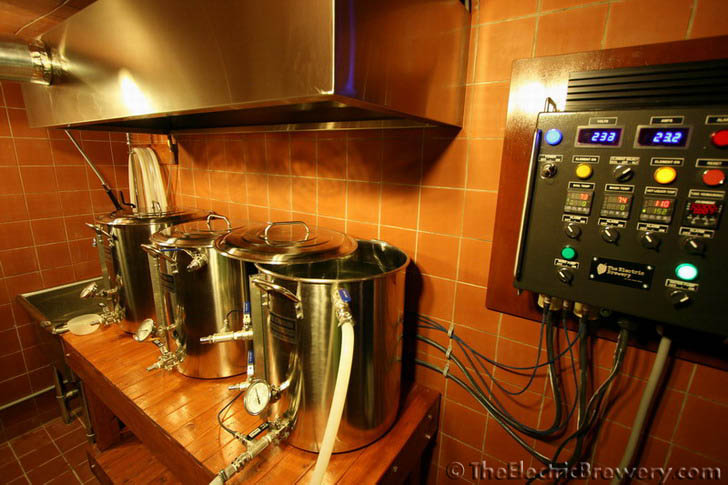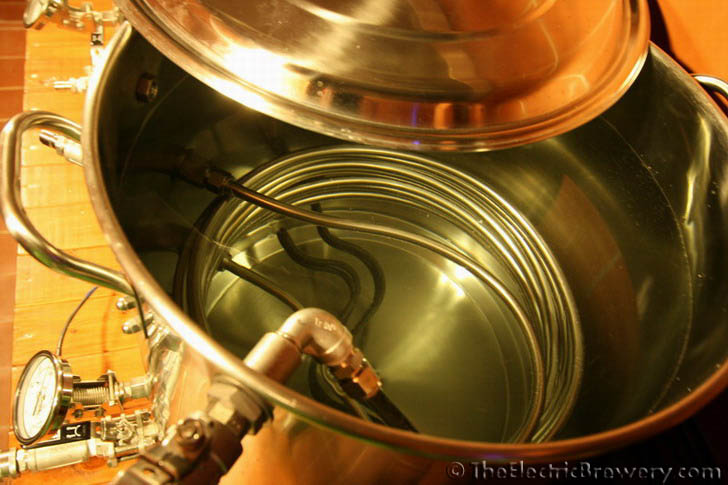kal
Well-Known Member
Note: I asked this question in a different thread but it was unrelated to the original subject so a separate thread probably makes more sense....
I'm trying to figure out my HERMS/mash process.
I plan on putting a temp probe on the output of my HERMS coil coming out of the HLT and let the PID set the HLT water temp. During mash one pump will recirc the HLT water to avoid stratification, another will recirc the MLT wort.
But I'm confused about overshoot/undershoot of strike and sparge temps since the HLT is doing dual duty. Seems many people do the setup I'm describing including stevehaun so I'll use his setup as an example:
The part I don't understand is how strike is done. So you fill both HLT and MLT with water, set the PID to, say, 156 and you mentioned that your mash water temp will then read about 154. Perfect. Both the MLT and HLT are nicely and warmed up.
But when you dump in all grain the temp of the MLT water is going to drop considerably due to the thermal mass. Do you just let it drop and let the system get back to 154? How long does that take? Or do you aim a bit high knowing that you're going to lose some when you dough-in?
This is the part that confuses me about having a HERMS coil in the HLT as really, the ideal setup is a HERMS coil some container OTHER than where you heat up your strike/sparge water. In other words, how do you get the right strike temp? If your HLT strike water's set much higher than your target to compensate for the grain cooling off the water when you dough-in, doing a constant re-circ of the wort through the same strike water in the HLT is going to then heat the wort too high even if you immediately after strike reduce your HLT water PID setting down to the desired time. Right?
Do you do this and let it overshoot and then settle down slowly? Or do you undershoot and let the system raise it slowly? One or the other's the only option right?
Kal
I'm trying to figure out my HERMS/mash process.
I plan on putting a temp probe on the output of my HERMS coil coming out of the HLT and let the PID set the HLT water temp. During mash one pump will recirc the HLT water to avoid stratification, another will recirc the MLT wort.
But I'm confused about overshoot/undershoot of strike and sparge temps since the HLT is doing dual duty. Seems many people do the setup I'm describing including stevehaun so I'll use his setup as an example:
I use one pid in my system. The thermocouple is located between the heat exchanger (herms coil) and the return manifold at the top of the mash tun. I fill my mash tun with the mash water and the HLT with the sparge water. I set my PID to my desired temp and start pumping the mash water thru the herms coil. The HLT heats up to several degrees above the temp I dialed in for my Mash tun and gradually my mash water is heated to the desired temp.
The part I don't understand is how strike is done. So you fill both HLT and MLT with water, set the PID to, say, 156 and you mentioned that your mash water temp will then read about 154. Perfect. Both the MLT and HLT are nicely and warmed up.
But when you dump in all grain the temp of the MLT water is going to drop considerably due to the thermal mass. Do you just let it drop and let the system get back to 154? How long does that take? Or do you aim a bit high knowing that you're going to lose some when you dough-in?
This is the part that confuses me about having a HERMS coil in the HLT as really, the ideal setup is a HERMS coil some container OTHER than where you heat up your strike/sparge water. In other words, how do you get the right strike temp? If your HLT strike water's set much higher than your target to compensate for the grain cooling off the water when you dough-in, doing a constant re-circ of the wort through the same strike water in the HLT is going to then heat the wort too high even if you immediately after strike reduce your HLT water PID setting down to the desired time. Right?
Do you do this and let it overshoot and then settle down slowly? Or do you undershoot and let the system raise it slowly? One or the other's the only option right?
Ok, so after the ~60 miinute mash you raise your PID temp from ~156 to 168 to raise the wort temp. Once the wort's at 168 the HLT water's at 175. Got it. But isn't 175F too hot for sparging? I thought you weren't supposed to go over 170F for sparge water because of tannin extraction.When my mash is completed, I set the temp to 168F. When I reach the desired mash out temp, my HLT water is about 175F
Kal




